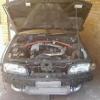Weekly Photo Challenge!
Announcements
-
Similar Content
-
Latest Posts
-
Thank you, this will keep me busy for a bit. I will update progression.
-
That specific one would be an exchange part, meaning I'd have to send mine to them. Plus it looks like a non AWD sump, which won't work for me. There is one or two shops in my country that I can ask to do a sump extension job and it'd most likely end up being cheaper than sending mine to AUS or NZ and getting one back, and quicker too.
-
Rear turbo is leaky, most likely at the oil drain. From what I could see with my boroscope it seemed to have seeped out at the very top of that return hose. Is it possible that the oil climbs up that hose to then leak out? Yup, coolant leak on the hot side of the engine, only noticed after seeing clear rusty residue in the block right from the turbo oil feed downwards to the pan, and red droplets hanging from the pan. No clear sign yet from where it comes, and most of the lines there are hardlines right? Last year, seeing those red drops, I thought it was power steering, will be glad if that is not leaky at least. Another leaking hose I found by chance is the lower of the two heater core hoses coming from the firewall to the back of the head. That one is not too bad to get to if I have to replace.
-
I think for response I'm already kind of out there no? he -5s are not the best pick for that as the Internet tells me. Maybe I should switch to -7s while I still can? Though that almost definitely warrants an engine pull along with the other issues I have.
-
Which I agree with. I don't want or need a high hp straight line car, I want it to be fun on the road and nothing more. Hence why I said my max power goal will be around 500 crank. The few times I drove the car last year I didn't even use high boost and it was already quick enough for me, should have been around 380-400 crank I think (2860-5s at 1-1.1bar).
-







Recommended Posts
Create an account or sign in to comment
You need to be a member in order to leave a comment
Create an account
Sign up for a new account in our community. It's easy!
Register a new accountSign in
Already have an account? Sign in here.
Sign In Now